Materials
The earliest locks were the interior wooden beams on city gates. Even the first real door locks, the pin tumbler locks, were made of hard wood. Chinese padlocks, on the other hand, are always made of bronze, brass, copper, iron, nickel, aluminum or silver. Bronze is the most common material, and this metal has such ancient roots in China that bronze production was probably invented there. Over 4,000 years ago, Chinese artisans were the first in the world to make bronze vessels in reusable molds, as opposed to the costly, complicated cire perdue (literally “lost wax”) method that was used in the Middle East and later in Europe. The shiny polished bronze vessels were used to hold wine and food sacrifices in the Chinese emperors’ ancestor worship.
Casting padlocks in bronze still occurs today, though on a smaller scale. Many of the padlocks, shaped like people, animals, musical instruments, bottles, knives and so on – that are sold to collectors at antique markets worldwide today are actually new-made, aged copies of ancient locks.
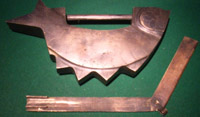 |
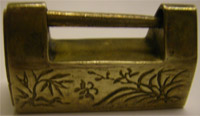 |
| Copper padlock. Photos by the author. |
Brass padlock. Photos by the author. |
Ornamentation
The “Ancient Romans” were the first people to put pictures on their padlocks. The lock collection of Heinrich Pankofer contains three Roman ring padlocks from the 3rd century decorated with animal masks. For more on Heinrich Pankofer, see the article on Collecting locks. His collection also includes a lovely selection of antique Oriental padlocks.
The various cultures of Asia had a great need to decorate their everyday utility objects – and naturally that included padlocks. In Buddhist and Hindu areas, padlocks are decorated with gods, demons, people, objects, animals and plant elements. Padlocks from Tibet picture demons, while those in Nepal have both demons and gods. In India, animals and gods are often portrayed, and the locks can also have inlays of silver on iron, brass on iron, enamel and cloisonné.
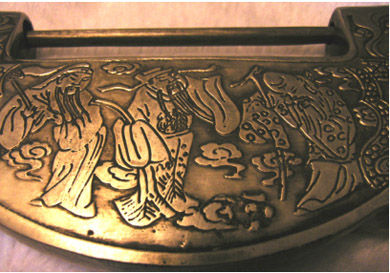 |
| Relief ornamentation on an aluminum lock. Photo by the author. |
Common motifs on Chinese locks are people, landscapes, imaginary beasts, birds, insects, plants and geometric designs. The ornamentation varies with the type of lock; box-shaped locks usually have engraved or etched characters, birds and plant elements, and reliefs. On the big, beautiful “wedding locks”, characters and ornamentation are usually etched or in relief.
The coin decorations on the big locks (see the pictures below) are easy to explain – riches are a part of the good fortune people strive for.
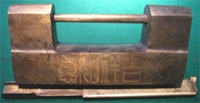 |
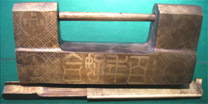 |
| Large box-shaped lock of bronze with etched text; both sides are shown. Note the coin designs. Photo by the author. |
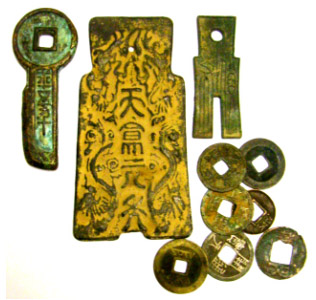 |
| Antique Chinese bronze coins: Key coin, spade coins (2) and cash coins. Photo by the author. |